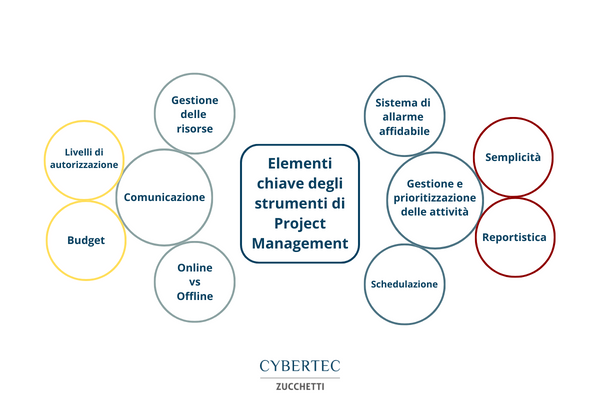One of the first things to keep in mind before you start managing a project is that planning takes time, but that doesn’t mean it’s a waste of resources. But if you feel like you’re always updating spreadsheets, looking for the compass among a thousand post-it notes attached to your agenda and desk, and your week is punctuated by endless team alignment meetings, you may not be using the right tools.
In fact, there are specific tools for project management that serve precisely to support people or teams in the organisation and effective management of projects and activities. These can be customized to meet the needs of teams of different sizes and with different goals.
Tools of this type are particularly useful when managing multi-project tasks or project groups with broader objectives, because they offer advanced features to track tasks at a higher level through flexible work views and cross-functional resource management, and to monitor how each project interacts with others with the help of dashboards and reporting.
Whatis Project Management
Project Management is the set of processes that are used to carry out a project, respecting the objectives and constraints of time, budget and resources.
Its task is to plan and coordinate the back and front office activities that make up a project, applying knowledge, attitudes, tools and techniques to all its phases. In doing so, try to minimize the risk factor, anticipating hazards and problems.
The project is managed by drawing up a detailed plan to achieve specific objectives and concrete results. The achievement of the objectives is made possible by the definition of some intermediate stages that allow progress to be made gradually.
The Gantt Chart
The Gantt chart is in all likelihood the tool most easily associated with project management. It is a very useful graph to visualize, represent and keep track of the timing and progress of a project, allowing a quick understanding of the elements of which a project is composed. Its versatility means that it can represent different projects in terms of type and size. It is useful in multi-project companies, when there are multiple projects carried out in parallel.
It is used in different phases of the project: in the initial phase it is part of the project management plan together with other documents and helps planning, in the execution phase it monitors progress and deviations from what was planned.
An advantage introduced by the Gantt chart is the subdivision of the project into smaller tasks, allowing you to monitor the dependence between being. In this way the team members are made more responsible, because they have indications on the links between the activities and how the delays of one affect the others. In general, it then facilitates communication by keeping the whole team updated on the status of the project and helps the team and management agree on what to do to achieve the objectives.
In short, thanks to its graphic nature it is easy to create and keep it updated and can offer great support in project management, especially if you use special software to manage it.
Agile Methodology
The agile methodology was born in the software industry and then spread to many other sectors. It is based on 12 principles collected in a manifesto and aims to increase team collaboration for greater efficiency. The agile method represents an alternative to the waterfall approach to streamline processes and identify and correct errors and defects more quickly, so great when you want to achieve goals quickly.
In the agile methodology, the work is based on short sessions called “sprints”, short impulses of activities that are repeated continuously in which the team tries to do as much as possible before moving on to the next phase. Repetition makes it easy to optimize processes, identify problems, and hit goals. The team is divided into smaller and consequently more focused groups, which meet often to discuss specific objectives, making work more flexible and facilitating corrective actions. Agile teams are therefore more effective because they better meet changing customer needs and are able to deliver projects faster.
In essence, the main advantages of the agile methodology are:
- Quickly developed solutions and reduced delivery times.
- Reduction of waste.
- Flexibility to adapt to change.
- Lean framework and optimized processes.
- Frequent and constant collaboration and feedback.
Considering the less formal processes on which the agile method is based, this approach is not always suitable for large companies with more traditional structures and may not be suitable in the case of large projects where it is difficult to estimate time.
Waterfall Method
The waterfall method is based on a series of sequential phases, where each task of a project follows the previous one in a continuous way. It is suitable for projects that start from clear and well-defined requirements, for which no changes are expected.
This method is used to develop the project life cycle with a linear and sequential approach. It is a step-by-step method, where the phases do not overlap and each one must be finished before the previous one since the output of each phase becomes the input of the next phase.
It consists of five phases:
- Requirements analysis: Identified and analyzed in a precise way to have them clear and understand the feasibility of the project.
- Design: the project is divided into the various activities and it is defined how to carry them out.
- Development: phase in which the project is carried out.
- Test: to detect problems in the output to be solved.
- Release: the output is placed on the market.
Software with tools for Project Management
Exploiting and amplifying the potential of these tools and methodologies is possible thanks to specific software for project management. There are many proposals on the market, but the choice can only depend on the needs of each company. Usually the factors taken into consideration are: number of users, key functionality required, scalability and ease of use.
In the case of companies that deal with multi-project activities, the features sought may concern:
- Planning and scheduling of activities through workflows and calendars.
- Collaboration to improve communication with the team, allowing you to assign tasks, comment, organize dashboards and approve changes, all without the need for endless email exchanges.
- Productivity assessment through efficient resource management.
- Strategic resource planning based on skills.
- Ability to plan scenarios and enter forecast orders.
CyberPlan RSP offers all these features and more. Whether you are the project manager of a technical office or the project manager of a consulting firm, you will have the opportunity to create interactive Gantt charts to plan projects in detail, short calendars to support the Agile methodology and graphs that highlight the activities carried out by the resources and the progress of the projects.

